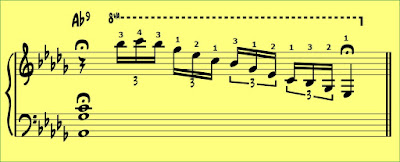Art Tatum: Musical Techniques and Concepts
In this series I propose to highlight what I consider some of Art Tatum’s
most exciting musical discoveries, ideas that I think we can and should use today. The idea of developing a driving left hand, a 'rhythm section' in itself, which at the same time has the subtlety to musically balance the right hand's ideas, is intriguing, a little bit like climbing Mount Everest. The art of making a rhythm section in your left hand hand while still swinging and playing what you want in your right hand - the ideal. It's an exciting challenge, and for me this thought started with Tatum, and has lately been extended by listening to Dave McKenna.
Please don't get me wrong on this: I love Bill Evans' solo style and all the other great players. The music changed with the times, the musicians went with it, even though there's plenty of proof now that those societal changes were orchestrated by external powerful forces that had virtually nothing to do with love of music.
First I propose to examine Tatum's use of descending right-hand runs and patterns, then his left-hand chordal concepts. I will be exploring Tatum's conceptual fingering style on runs, not so much his random 'fill-in' improvisations, found in any of his transcriptions, where his notes choices in the right hand 'disagree' with the chord to the extent that you start to realize he's using the pianistic feel of the keys (what feels good under the fingers/keys) as opposed to a thought-out lick on a chord.
Please don't get me wrong on this: I love Bill Evans' solo style and all the other great players. The music changed with the times, the musicians went with it, even though there's plenty of proof now that those societal changes were orchestrated by external powerful forces that had virtually nothing to do with love of music.
First I propose to examine Tatum's use of descending right-hand runs and patterns, then his left-hand chordal concepts. I will be exploring Tatum's conceptual fingering style on runs, not so much his random 'fill-in' improvisations, found in any of his transcriptions, where his notes choices in the right hand 'disagree' with the chord to the extent that you start to realize he's using the pianistic feel of the keys (what feels good under the fingers/keys) as opposed to a thought-out lick on a chord.
The key point in this concept is to realize is that the right hand is subordinate to the left hand: the left hand is the rhythmic anchor, so everything in the right hand is basically 'whatever you can fit in'. That's why the runs have to sound effortless, because the time feel is all-important. And that's why so many of Tatum's "random fill-ins", as I call them, are not chord-melody based but literally finger or hand-shape based.
To get back to my theme, by examining Tatum's music - much like Charlie Parker's - I believe we are opening the door to further discoveries in the world of classic jazz arranging.
So in describing these runs and their fingerings, I would
like to stress that I am concentrating on a relatively minor part of the total musical
experience. I get that. What I'm doing is zooming in on a particular facet of Tatum’s performance, for
which he is deservedly well-known, and exploring it. But in what we might call good all-round musical
practice, harp-like runs such as Tatum used would constitute a relatively small
part of the solo jazz pianist’s total bag of tricks. No-one is ever going to outdo Tatum,
and more importantly no-one is ever going to sound like the real emotional Tatum, the one I love, not the flashy one. And so we have to realise that in order to incorporate some of his devices in our own playing, we have to do a
hell of a lot of work for a relatively brief musical result. To be able to use them at
all musically, it takes many hours practicing a run, thousands of times over,
until it can be incorporated naturally
in a jazz performance. It takes years for it to come out naturally (unless you're working 6 nights a week). Again, that particular run or partial-run maybe lasting for only a second or
two in actual performance.
What I am getting at is that we can use and should build
upon the techniques of the past, such as these Tatum runs, to add to our
arsenal of solo piano techniques.
Future posts will explore Tatum fingerings for descending 9ths and 13th runs.














